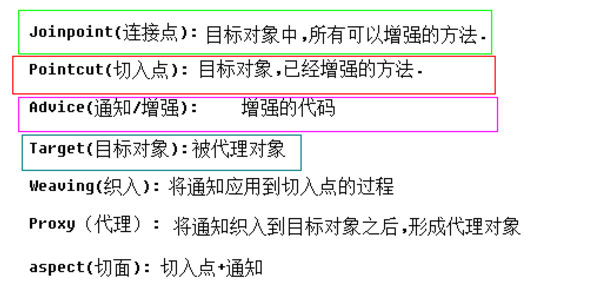1.使用注解配置spring
(1)导包:4+2+spring-aop-4.2.4.RELEASE.jar
(2)引入aop约束
(3)applicationContext.xml中开启使用注解代理配置文件:
<context:component-scan base-package="com.xing.bean"></context:component-scan><!-component-scan部件扫描->(4)将对象注册到容器
<?xml version="1.0" encoding="UTF-8"?>
<beans xmlns:xsi="http://www.w3.org/2001/XMLSchema-instance" xmlns="http://www.springframework.org/schema/beans" xmlns:context="http://www.springframework.org/schema/context" xsi:schemaLocation="http://www.springframework.org/schema/beans http://www.springframework.org/schema/beans/spring-beans-4.2.xsd http://www.springframework.org/schema/context http://www.springframework.org/schema/context/spring-context-4.2.xsd ">
<!-- 开启扫描注解 -->
<context:component-scan base-package="com.xing.bean"></context:component-scan>
<bean name="car2" class="com.xing.bean.Car" init-method="init" destroy-method="destroy">
<property name="name" value="奔驰"></property>
<property name="color" value="白色"></property>
</bean>
</beans>(5)代码演示
package com.xing.bean;
import javax.annotation.PostConstruct;
import javax.annotation.PreDestroy;
import javax.annotation.Resource;
import javax.xml.ws.WebServiceProvider;
import org.springframework.beans.factory.annotation.Autowired;
import org.springframework.beans.factory.annotation.Qualifier;
import org.springframework.beans.factory.annotation.Value;
import org.springframework.context.annotation.Scope;
import org.springframework.stereotype.Component;
import org.springframework.stereotype.Controller;
import org.springframework.stereotype.Repository;
import org.springframework.stereotype.Service;
//相当于<bean name="user" class="com.xing.bean.User" scope="" value="" ></bean>
//@Component("user")//将对象注册到容器有四种写法,而下面三种可以可以知道对象的位置信息,而@Component是原始的注解,不能包含对象的位置信息
//@Service("user")---service层
//@Repository("user")-----dao层
@Controller("user")//-----web层
//@Scope(scopeName="prototype")//指定对象的作用范围
public class User {
@Value("tom")
private String name;
@Value("18")
private Integer age;
//给引用类型赋值:两种方式
//1.@Autowired//按照类型自动装配,缺点:容器内同类对象有多个时无法匹配到是哪一个,需要借助Qualifier
//@Qualifier("car2")//使用@Qualifier注解告诉spring容器自动装配哪个对象
//2.@Resource name指定对象
@Resource(name="car2")
private Car car;
@PostConstruct//在对象被创建后执行-----init-method
public void init() {
System.out.println("初始化方法。。。");
}
@PreDestroy//在对象被销毁前执行-----destroy-method
public void destroy() {
System.out.println("销毁方法。。。");
}
public String getName() {
return name;
}
public void setName(String name) {
this.name = name;
}
public Integer getAge() {
return age;
}
@Value("20")
public void setAge(Integer age) {
this.age = age;
}
public Car getCar() {
return car;
}
public void setCar(Car car) {
this.car = car;
}
@Override
public String toString() {
return "User [name=" + name + ", age=" + age + ", car=" + car + "]";
}
}
//测试
package com.xing.annotation;
import org.junit.Test;
import org.springframework.context.ApplicationContext;
import org.springframework.context.support.ClassPathXmlApplicationContext;
import com.xing.bean.Car;
import com.xing.bean.User;
public class test {
@Test
public void test1() {
ClassPathXmlApplicationContext ac=new ClassPathXmlApplicationContext("applicationContext.xml");
User u=(User) ac.getBean("user");
User u2=(User) ac.getBean("user");
System.out.println(u==u2);
System.out.println(u);
ac.close();//ClassPathXmlApplicationContext
}
@Test
public void test2() {
ApplicationContext ac = new ClassPathXmlApplicationContext("applicationContext.xml");
Car c=(Car) ac.getBean("car2");
System.out.println(c);
}
}
2.spring和Junit整合
(1)导包:4+2+spring-aop-4.2.4.RELEASE.jar+spring-test-4.2.4.RELEASE.jar
(2)配置注解及测试代码
package com.xing.annotation;
import javax.annotation.Resource;
import org.junit.Test;
import org.junit.runner.RunWith;
import org.springframework.test.context.ContextConfiguration;
import org.springframework.test.context.junit4.SpringJUnit4ClassRunner;
import com.xing.bean.User;
//帮助我们创建容器
@RunWith(SpringJUnit4ClassRunner.class)
//指定创建容器时使用哪个配置文件
@ContextConfiguration("classpath:applicationContext.xml")
public class test2 {
//把对象user注入到变量u
@Resource(name="user")
private User u;
@Test
public void test1() {
System.out.println(u);
}
}
3.spring中的aop思想介绍
(1)横向覆盖,纵向抽取(AOP思想应用:解决乱码,管理事务,拦截器)

(2)spring实现AOP的原理
动态代理(优先):被代理对象必须实现接口,才能产生代理对象。如果没有接口,则不能使用动态代理技术(补充:动态代理是指代理对象实现被代理对象的接口,重写一些方法)
cglib代理:没有接口,是第三方的代理技术,可以对任何类生成代理,代理的原理是对目标对象进行继承代理,如果目标对象被final修饰,那么该类无法被cglib代理
4.spring中的aop演示
aop名词学习:

(1)导包:4(基础包)+2(日志包)+2个spring的aop包(spring-aop-4.2.4.RELEASE.jar+spring-aspects-4.2.4.RELEASE.jar)+2个spring需要的第三方aop包(com.springsource.org.aopalliance联盟-1.0.0.jar+com.springsource.org.aspectj.weaver织入-1.6.8.RELEASE.jar)
(2)准备目标对象
package com.xing.service;
//目标对象
public class UserServiceImpl implements UserService{
@Override
public void save() {
System.out.println("这是保存用户方法");
// int i=1/0;
}
@Override
public void delete() {
System.out.println("这是删除用户方法");
}
@Override
public void update() {
System.out.println("这是更新用户方法");
}
@Override
public void find() {
System.out.println("这是查找用户方法");
}
}
(3)准备通知类
package com.xing.springAOP;
import org.aspectj.lang.ProceedingJoinPoint;
//通知类
public class MyAdvice {
// 前置通知
// |-目标方法运行之前调用
//后置通知(如果出现异常不会调用)
// |-在目标方法运行之后调用
//环绕通知
// |-在目标方法之前和之后都调用
//异常拦截通知
// |-如果出现异常,就会调用
//后置通知(无论是否出现 异常都会调用)
// |-在目标方法运行之后调用
// 前置通知
public void before() {
System.out.println("这是前置通知");
}
//后置通知(如果出现异常不会调用)
public void afterReturning() {
System.out.println("这是后置通知(如果出现异常不会调用)");
}
//环绕通知
public Object around(ProceedingJoinPoint pjp) throws Throwable {
System.out.println("这是环绕通知之前的部分");//可用于开启事务
Object proceed = pjp.proceed();//调用目标方法
System.out.println("这是环绕通知之后的部分");
return proceed;
}
//异常拦截通知
public void afterException() {
System.out.println("这是异常拦截通知。。。");
}
//后置通知
public void after() {
System.out.println("这是后置通知(是否出现异常都会调用)");
}
}
(4)在spring配置文件中将通知织入目标对象中
<?xml version="1.0" encoding="UTF-8"?>
<beans xmlns:xsi="http://www.w3.org/2001/XMLSchema-instance" xmlns="http://www.springframework.org/schema/beans" xmlns:context="http://www.springframework.org/schema/context" xmlns:aop="http://www.springframework.org/schema/aop" xsi:schemaLocation="http://www.springframework.org/schema/beans http://www.springframework.org/schema/beans/spring-beans-4.2.xsd http://www.springframework.org/schema/context http://www.springframework.org/schema/context/spring-context-4.2.xsd http://www.springframework.org/schema/aop http://www.springframework.org/schema/aop/spring-aop-4.2.xsd ">
<!-- 准备工作: 导入aop(约束)命名空间 -->
<!-- 1.配置目标对象 -->
<bean name="userService" class="cn.itcast.service.UserServiceImpl" ></bean>
<!-- 2.配置通知对象 -->
<bean name="myAdvice" class="cn.itcast.d_springaop.MyAdvice" ></bean>
<!-- 3.配置将通知织入目标对象 -->
<aop:config>
<!-- 配置切入点
public void cn.itcast.service.UserServiceImpl.save()
void cn.itcast.service.UserServiceImpl.save()
* cn.itcast.service.UserServiceImpl.save()
* cn.itcast.service.UserServiceImpl.*()
* cn.itcast.service.*ServiceImpl.*(..)-----*:任何类型的;*:后缀名为ServiceImpl的类;*:任何方法;..:参数
* cn.itcast.service..*ServiceImpl.*(..)-------..:后缀名为ServiceImpl的类以及子包
-->
<aop:pointcut expression="execution(* cn.itcast.service.*ServiceImpl.*(..))" id="pc"/>
<aop:aspect ref="myAdvice" >
<!-- 指定名为before方法作为前置通知,并指定切点 -->
<aop:before method="before" pointcut-ref="pc" />
<!-- 后置 -->
<aop:after-returning method="afterReturning" pointcut-ref="pc" />
<!-- 环绕通知 -->
<aop:around method="around" pointcut-ref="pc" />
<!-- 异常拦截通知 -->
<aop:after-throwing method="afterException" pointcut-ref="pc"/>
<!-- 后置 -->
<aop:after method="after" pointcut-ref="pc"/>
</aop:aspect>
</aop:config>
</beans>//测试
package com.xing.springAOP;
import javax.annotation.Resource;
import org.junit.runner.RunWith;
import org.springframework.test.context.ContextConfiguration;
import org.springframework.test.context.junit4.SpringJUnit4ClassRunner;
import com.xing.service.UserService;
@RunWith(SpringJUnit4ClassRunner.class)
@ContextConfiguration("classpath:com/xing/springAOP/applicationContext.xml")
public class Test {
@Resource(name="userService")
UserService us;//代理对象
@org.junit.Test
public void test1() {
us.save();
System.out.println("---------------------------------");
us.delete();
}
}
使用注解的方式把通知织入目标对象:
<?xml version="1.0" encoding="UTF-8"?>
<beans xmlns:xsi="http://www.w3.org/2001/XMLSchema-instance" xmlns="http://www.springframework.org/schema/beans" xmlns:aop="http://www.springframework.org/schema/aop" xsi:schemaLocation="http://www.springframework.org/schema/beans http://www.springframework.org/schema/beans/spring-beans-4.2.xsd http://www.springframework.org/schema/aop http://www.springframework.org/schema/aop/spring-aop-4.2.xsd ">
<!-- 准备工作: 导入aop(约束)命名空间 -->
<!-- 1.配置目标对象 -->
<bean name="userService" class="com.xing.service.UserServiceImpl"></bean>
<!-- 2.配置通知对象 -->
<bean name="myAdvice" class="com.xing.springaopAnnotation.MyAdvice"></bean>
<!-- 3.开启使用注解完成织入 -->
<aop:aspectj-autoproxy></aop:aspectj-autoproxy>
</beans>package com.xing.springaopAnnotation;
import org.aspectj.lang.ProceedingJoinPoint;
import org.aspectj.lang.annotation.After;
import org.aspectj.lang.annotation.AfterReturning;
import org.aspectj.lang.annotation.AfterThrowing;
import org.aspectj.lang.annotation.Around;
import org.aspectj.lang.annotation.Aspect;
import org.aspectj.lang.annotation.Before;
import org.aspectj.lang.annotation.Pointcut;
//通知类
//表示这是一个通知类
@Aspect
public class MyAdvice {
// 前置通知
// |-目标方法运行之前调用
//后置通知(如果出现异常不会调用)
// |-在目标方法运行之后调用
//环绕通知
// |-在目标方法之前和之后都调用
//异常拦截通知
// |-如果出现异常,就会调用
//后置通知(无论是否出现 异常都会调用)
// |-在目标方法运行之后调用
@Pointcut("execution(* com.xing.service.*ServiceImpl.*(..))")
public void pc() {};
// 前置通知
@Before("MyAdvice.pc()")//这是简化后的写法,需要有上面的方法才行
public void before() {
System.out.println("这是前置通知");
}
//后置通知(如果出现异常不会调用)
@AfterReturning("execution(* com.xing.service.*ServiceImpl.*(..))")//这是第一种写法
public void afterReturning() {
System.out.println("这是后置通知(如果出现异常不会调用)");
}
//环绕通知
@Around("execution(* com.xing.service.*ServiceImpl.*(..))")
public Object around(ProceedingJoinPoint pjp) throws Throwable {
System.out.println("这是环绕通知之前的部分");//可用于开启事务
Object proceed = pjp.proceed();//调用目标方法
System.out.println("这是环绕通知之后的部分");
return proceed;
}
//异常拦截通知
@AfterThrowing("execution(* com.xing.service.*ServiceImpl.*(..))")
public void afterException() {
System.out.println("这是异常拦截通知。。。");
}
//后置通知
@After("execution(* com.xing.service.*ServiceImpl.*(..))")
public void after() {
System.out.println("这是后置通知(是否出现异常都会调用)");
}
}
//测试
package com.xing.springaopAnnotation;
import javax.annotation.Resource;
import org.junit.Test;
import org.junit.runner.RunWith;
import org.springframework.test.context.ContextConfiguration;
import org.springframework.test.context.junit4.SpringJUnit4ClassRunner;
import com.xing.service.UserService;
@RunWith(SpringJUnit4ClassRunner.class)
@ContextConfiguration("classpath:com/xing/springaopAnnotation/applicationContext.xml")
public class TMyest {
@Resource(name="userService")
private UserService us;
@Test//import org.junit.Test;
public void test1() {
us.save();
}
}





















 180
180

 被折叠的 条评论
为什么被折叠?
被折叠的 条评论
为什么被折叠?








